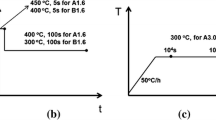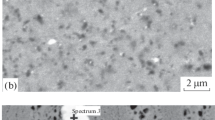Abstract
The ageing responses of surface/centre layer materials from a commercially produced AA7150 thick plate have been studied after both water quenching (WQ) and air cooling (AC). The results show that the higher degree of recrystallisation near the plate surface decreases its age hardening response in AC condition. Quench-induced phases have been found to precipitate preferentially on Al3Zr dispersoids in recrystallised grains. Microstructural observations show that Al3Zr dispersoids in recrystallised grains exhibit the same crystal structure and orientation as those in adjacent subgrains.




Similar content being viewed by others
References
Polmear IJ (2006) Light alloys/metallurgy of the light metals, 4th edn. Pergamon press, Melbourne
Zieliński A et al (2002) Influence of retrogression and reaging (RRA) heat treatment on microstructure, mechanical and chemical behaviour of an Al–Zn–Mg alloy. Adv Mater Sci 2(1):33–41
Robinson JS (2000) Influence of retrogressing and reaging on the stress corrosion cracking resistance of 7010 in 7th International conference on aluminium alloys, Charlottesville, VA, USA
Xu DK, Rometsch PA, Birbilis N (2012) Improved solution treatment for an as-rolled Al-Zn-Mg-Cu alloy. Part II. Microstructure and mechanical properties. Mater Sci Eng A 534:244–252
Zhang X et al (2011) Effect of Processing Parameters on Quench Sensitivity of an AA7050 sheet. Mater Sci Eng A 528:795–802
Suzuki H, Kanno M, Saitoh H (1984) The Effect of Zr or Cr Addition on the Recrystallization Behavior of Al-Zn-Mg-Cu Alloys. J Japan Inst Light Met 34(11):630–636
Park JK, Ardell AJ (1983) Microstructures of the Commercial 7075 AI Alloy in the T651 and T7 Tempers. Metall Trans A 14A:1957–1965
Liu S et al (2010) Investigation of Quench Sensitivity of High Strength Al-Zn-Mg-Cu alloys by time-temperature-properties Diagrams. Mater Des 31:3116–3120
Fridlyander IN (2001) Aluminum Alloys in Aircraft in the periods of 1970-2000 and 2001-2015. Met Sci Heat Treat 43(1–2):6–10
Liu. J (2006) Advanced aluminum and hybrid aerostructures for future aircraft. Mater Sci Forum 519-521:1233–1238
Starke EA, Staley JT (1996) Application of modern aluminum alloys to aircraft. Prog Aerosp Sci 32:131–172
Robson JD, Prangnell PB (2001) Dispersoid precipitation and process modelling in zirconium contaning commercial aluminium alloys. Acta Mater 49:599–613
Deschamps A et al (2009) Influence of cooling rate on the precipitation microstructure in a medium strength Al-Zn-Mg alloy. Mater Sci Eng A 501:133–139
Schöbel M, Pongratz P, Degischer HP (2012) Coherency loss of Al3(Sc, Zr) precipitates by deformation of an Al–Zn–Mg alloy. Acta Mater 60(10):4247–4254
Robson JD (2004) Microstructural Evolution in Aluminium alloy 7050 during Processing. Mater Sci Eng A 382:112–121
Kanno M, Ou B-L (1991) Heterogeneous Precipitation of Intermediate Phases on Al3Zr Particles in Al-Cu-Zr and Al-Li-Cu-Zr Alloys. Mater Trans 32(5):445–450
Nes E (1972) Precipitation of the Metastable Cubic Al3Zr-phase in Subperitectic Al-Zr Alloys. Acta Mater 20(4):499–506
Sigli C (2004) Zirconium solubility in aluminum alloys. Mater Forum 28:1353–1358
Thompson DS, Subramanya BS, Levy SA (1970) Quench Rate Effects in AI-Zn-Mg-Cu Alloys. Metall Trans 2:1149–1150
Ryum N (1968) Precipitation and recrystallization in an Al-0.5 wt% Zr-Alloy. Acta Mater 17:269–278
Robson JD (2004) A new model for prediction of dispersoid precipitation in aluminium alloys containing zirconium and scandium. Acta Mater 52:1409–1421
Xu DK, Rometsch PA, Birbilis N (2012) Improved solution treatment for an as-rolled Al-Zn-Mg-Cu alloy. Part I. characterisation of constituent particles and overheating. Mater Sci Eng A 534:234–243
Zhang Y, Rometsch PA, Muddle BC (2011) Characterisation and control of Al3Zr dispersoids in Al-Zn-Mg-Cu-Zr alloys in European conference on aluminium alloys, DGM, Bremen, Germany
Acknowledgements
The authors thank the Aluminium Corporation of China Ltd (Chalco) for supporting this work financially and providing materials as part of the Australia-China International Centre for Light Alloy Research (ICLAR). The ARC Centre of Excellence for Design in Light Metals and the Monash Centre for Electron Microscopy (MCEM) are also acknowledged.
Author information
Authors and Affiliations
Corresponding author
Rights and permissions
About this article
Cite this article
Zhang, Y., Bettles, C. & Rometsch, P.A. Effect of recrystallisation on Al3Zr dispersoid behaviour in thick plates of aluminium alloy AA7150. J Mater Sci 49, 1709–1715 (2014). https://doi.org/10.1007/s10853-013-7856-x
Received:
Accepted:
Published:
Issue Date:
DOI: https://doi.org/10.1007/s10853-013-7856-x




